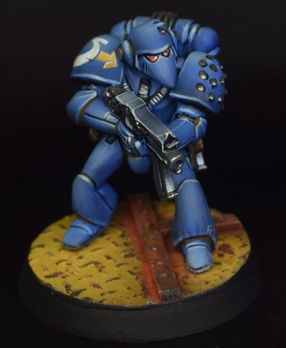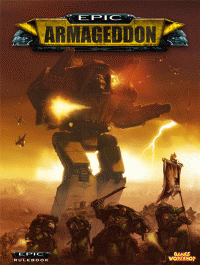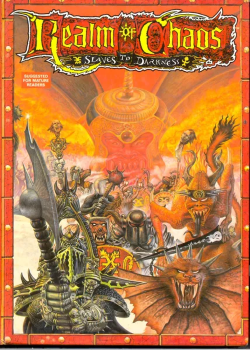
Warhammer 40,000 is a miniature wargame produced by Games Workshop. It is the most popular miniature wargame in the world, and is particularly popular in the United Kingdom. The first edition of the rulebook was published in September 1987, and the tenth and current edition was released in June 2023.

Games Workshop Group is a British manufacturer of miniature wargames, based in Nottingham, England. Its best-known products are Warhammer and Warhammer 40,000.

In the fictional universe of Warhammer 40,000, the Space Marines, also known as the Adeptus Astartes, are superhuman warrior-monks who fight for the Imperium of Man. They wear mechanised suits of armour and have modified genomes that grant them superhuman strength and endurance. Some Space Marines have betrayed the Imperium and serve the Gods of Chaos, and are thus known as Chaos Space Marines.
Battlefleet Gothic is a naval miniature wargame that was produced by Games Workshop from 1999 to 2013 with Andy Chambers as the primary developer. A spin-off of the science-fantasy setting of Warhammer 40,000, the game has players command fleets of large spaceships belonging to one of several spaceborne factions. Although the wargame's miniatures and rulebooks are no longer supported by Games Workshop, two video game adaptations have been made since its cancellation in 2013.

Epic is a series of tabletop wargames set in the fictional Horus Heresy and Warhammer 40,000 universes. Whereas Warhammer 40,000 involves small battles between forces of a few squads of troops and two or three vehicles, Epic features battles between armies consisting of dozens of tanks and hundreds of soldiers. Due to the comparatively larger size of the battles, Epic miniatures are smaller than those in Warhammer 40,000, with a typical human being represented with a 6mm high figure, as opposed to the 28mm minis used in Warhammer 40,000. Since being first released in 1988 as Adeptus Titanicus, it has gone through various editions with varying names.

Warhammer is a tabletop miniature wargame with a medieval fantasy theme. The game was created by Bryan Ansell, Richard Halliwell, and Rick Priestley, and first published by the Games Workshop company in 1983.
Inquisitor was a tabletop miniatures game based in Games Workshop's Warhammer 40,000 universe. Whereas the main line of Warhammer 40K games is based on squad based tactical warfare, Inquisitor focused on a small group of player characters akin to many role-playing games. Inquisitor miniatures are no longer produced by Games Workshop but, whilst they were, the game had its own website and 54 mm scale models were available as "Specialist Games" from the Games Workshop catalogue.
BL Publishing was a division of Games Workshop, and was split into three sections:

The Black Library is a division of Games Workshop which is devoted to publishing novels and audiobooks set in the Warhammer Fantasy Battle, Warhammer Age of Sigmar and Warhammer 40,000 fictional universes. Some of Black Library's best known titles include the Gaunt's Ghosts and Eisenhorn series of novels by Dan Abnett and the Gotrek and Felix series by William King and Nathan Long.

A codex, in the Warhammer 40,000 tabletop wargame, is a rules supplement containing information concerning a particular army, environment, or worldwide campaign.
Aeronautica Imperialis is the name of two tabletop miniature wargames set within the Warhammer 40,000 universe. The games depict aerial warfare between different factions in the setting, either as one-off battles or as part of a larger narrative campaign. The first edition was released in January 2007 by Forge World, a division of the British gaming company Games Workshop. The second edition, a relaunch via Games Workshop, was released in August 2019 with a different ruleset and new, larger models.

Andy Chambers is an English author and game designer best known for his work on over 30 Games Workshop rulebooks and sourcebooks.
Jervis Johnson is an English tabletop game designer. He worked as a designer and manager for Games Workshop for over 38 years, and was the head of its Specialist Games studio. In addition to his work on Warhammer Fantasy Battles and Warhammer 40,000, he created the fantasy football game Blood Bowl, and co-created Epic 40,000, Necromunda, and Age of Sigmar.
Warhammer 40,000 comics are spin-offs and tie-ins based in the Warhammer 40,000 fictional universe. Over the years these have been published by different sources. Originally appearing in Inferno! and Warhammer Monthly, the initial series of stories have been released as trade paperbacks by Black Library, who have also released original graphic novels and shorter prestige format comics.

Warhammer 40,000 Apocalypse is an expansion to the Warhammer 40,000 tabletop miniatures wargame by the British gaming company Games Workshop. It contains rules which allow players to field massive armies the likes of which are unwieldy using the basic Warhammer 40,000 ruleset. It also allows players to field units that are not available in normal Warhammer 40,000 games, such as large super-heavy tanks and robot-like titans, some of which can stand up to 400 feet in game-scale height.

Deathwatch is a role-playing game published in 2010 that uses the Warhammer 40,000 Roleplay system.

Battlefleet Gothic: Armada is a real-time tactics video game developed by Tindalos Interactive and published by Focus Home Interactive. It is set in the fictional universe of Warhammer 40,000, and is specifically an adaptation of the miniature wargame Battlefleet Gothic by Games Workshop.
Richard Fretson Halliwell was a British game designer who worked at Games Workshop (GW) during their seminal period in the 1980s, creating many of the games that would become central to GW's success.

Realm of Chaos: Slaves to Darkness is a 1988 role-playing game supplement for Warhammer Fantasy Roleplay published by Games Workshop.












